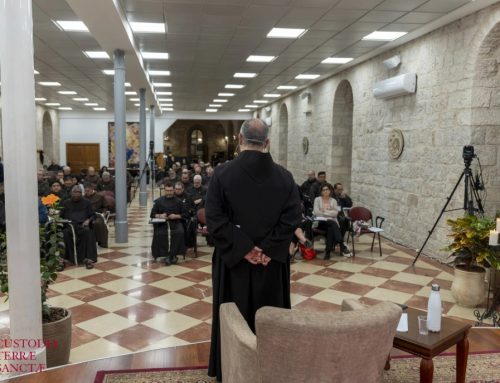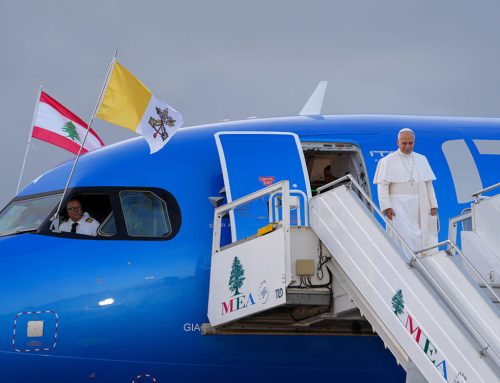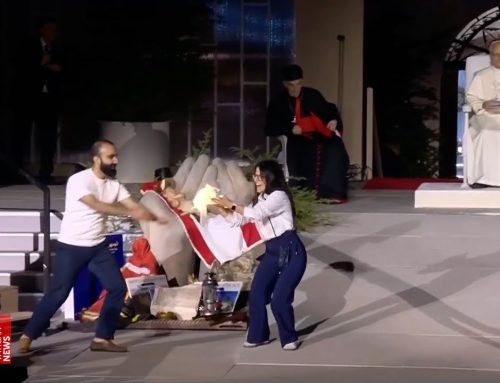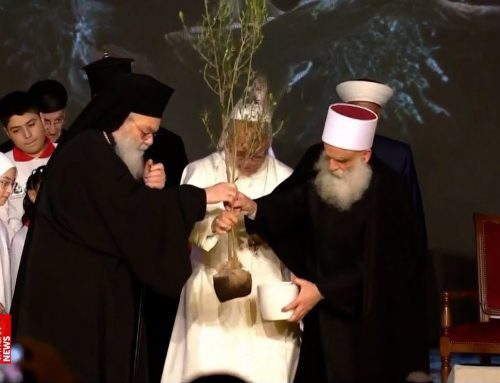
There are also doctors, engineers, as well as renowned academics living in Gaza. Christians in Gaza have varying views about being under the control of Hamas, but they all appreciate the fact that Hamas provides them security and allows them to practice their religion freely, without coercion to do otherwise.
Gaza Beach
Jaber al-Jalda, Religious Relations Manager for the Greek Orthodox Church in the Strip, reports that, “There are 1,500 Christians in the Gaza Strip, divided into two parts based on geographical origins: Christians whose roots are in Gaza and those whose families had emigrated to Gaza after al-Nakba in 1948.” Al-Jalda delineates the Christians who live in Gaza into four denominations: Greek Orthodox (the majority Christian group), Catholics, Baptists and Evangelicals (these last two being the fewest in number).
Siege as the Reason for Immigration
Jaber al-Jalda notes that the number of Palestinian Christians in Gaza has declined over the past six years, from 3,500 to only 1,500, due to the immigration of hundreds of Christian youth. He denied that the immigration was due to any pressure Christians felt from Hamas, stressing that most of the immigrants were youth who left Gaza to study abroad, and, upon graduation, preferred to remain abroad. This is because they would not have been able to find work in the besieged Gaza Strip. Al-Jalda emphasizes that Christians live with the same rights as the Muslims and don’t face any pressure from Hamas. They also participate with Muslims in social events, visiting each other’s families. Some Christian families, for example, live in Muslim neighborhoods and don’t feel like outsiders. Al-Jalda stresses the point that the hardships forced on the residents of Gaza do not discriminate between Christians and Muslims. All of them live under the siege and have been equally exposed during the wars to the blind rockets Israel. Israeli officials claims to have given more freedom to Christians, allowing them to move to and from the Gaza Strip, but these claims are misleading.
Al-Jalda states that, “Christian Arabs have been subject to the same restrictions as their Muslim counterparts. This so-called freedom that has been provided by Israel to Christians only allows them to go on a pilgrimage to the Church of Nativity once a year. But these Christian pilgrims must be less than sixteen years old or more than thirty-five years old. It is Israeli policy to refuse passage to Christian Arabs that fall into these age ranges, completely nulling any freedom Israel claims to have provided.” Al-Jalda also states, “Despite the economic hardships that tempt some Christians to immigrate, many remain steadfast along side their Muslim peers. They will continue their struggle against Israeli occupation, as they are the rightful heirs to the land and its history. Christian churches in the area date back to before 1650 A.D., and most of the Greek Orthodox Christians in Gaza pray in the church of St. Porphyrius, which sits in the heart of a Muslim neighborhood, adjacent to a mosque. The church of St. Porphyrius is also one of the most popular historical sites in Gaza. It was built from ancient stones, and inside there is a large courtyard where Christians are taught about the Bible.
Elias al-Jalda, one of the most renowned Christians living in Gaza, confirms that the Christians in the Strip are not guests or foreigners to the community, they are heirs to the land whose ancestors have lived their for hundreds of years. These Christian contribute to the economy of Gaza, living in strategic business locations. Al-Jalda adds that the role Christians play in the economy allows them to establish positive relationships within the Muslim community and carry on normal lives to such an extent that you cannot distinguish between Muslims and Christians. Al-Jalda also points out that the Christians participate with their Muslim peers in the struggle against the Israeli occupation, and that individuals of both faiths have been wounded, martyred or detained by Israel. This joint struggle strengthens the bonds between Christians and Muslims. They are partners in blood and sacrifice, as they have been throughout the history of Palestine. The Israelis have attempted to incite conflict and create division between Christians and Muslims, but these attempts have ultimately failed.
Provocative Actions
Elias al-Jalda has criticized Hamas for exaggerating some aspects of life in Gaza, especially the number of Christian to Islam converts. He says that after the split between Fatah and Hamas (the two main political parties in Palestine) and Israel’s siege of Gaza, communication between Christians in the West Bank and Christians in Gaza became in infrequent and difficult. This has made it difficult for Christians to marry one another. As a result of this, interfaith marriages between Christians and Muslims in Gaza increased. In such marriages, one of the partners is forced to convert to the other’s religion. Al-Jalda insists that, “This did not occur while the Palestinian Authority was in charge of Gaza, prior to Hamas coming into power.” He also criticized Hamas Security for making border crossing increasingly difficult for Christians through invasive searches. There is no written law that justifies such discrimination and scrutiny, so Christians have complained to several officials in Gaza.
Al-Jada also states that, “There exists discrimination in the workplace, not only against Christians, but also against any Palestinian who does not align himself with Hamas. This elicits great stress from youth, both Christian and Muslim, who are attempting to begin their adult lives.” He goes on to say, “Maybe this discrimination is the cause of immigration among youth. The number of Christians emigrating from Gaza increased once Hamas came into power. Some Muslims emigrated as well, but the number of Christians who have left Gaza is much higher.” While the Palestinian Authority was in power and Yasser Arafat was president, Christians were treated well, having many opportunities for education and employment. Some Christians describe the era of the late President Arafat as a golden age. Under Arafat’s authority they were provided rights and freedom in an unprecedented way.
Partner in Goals and Sacrifices
Father Manuel Musallam, the Head of the Christian World in the Office of International Relations of Christianity, and the head of the Catholic Church in the Gaza Strip, as well as member of the Islamic Christian Support of Jerusalem Holy Sites, rejected the term describing the relationships between Christians and Muslims in Gaza, stressing that, “All Palestinians live together in Palestine and they are partners in the case of sacrifice and struggle, they are a unified people of a unified history.”
The Christian Gaza
The Palestinians started becoming Christians during Rome’s rule over the land, but the faith did not truly flourish until the Byzantine Empire declared Christianity the state religion. The first person to preach in Gaza was Philip, a student of St. Paul the Apostle. In the Bible it is written that Jesus, Mary, and Joseph came through Gaza once they returned from Egypt, after the death of Herod. The best known preacher in Gaza was Saint Hilarion, who helped convert the people of Gaza to Christianity. By the time Bishop Parvirius died in 430 A.D., most people in Gaza were Christian. There was a church built in the name of Parvirius that still stands today. Prior to the Israeli occupation of Gaza in 1967, there were 10,000 Christians in the area. It was projected that there would be 30,000 Christians in Gaza by 2010, but the number of Christians had decreased to 5,000 by 2007. This number continued to fall as Hamas came into control. In 2012 there were only 2,700 Christians in Gaza. Father Musallam said that, “The world has watched Israel lose its moral and social credibility due to its wars against the Palestinians and the divisiveness Israel tries to create between Christians and Muslims. Israel has become a despised outcast among nations for this. In fact, Israel is to blame for the so-called ‘Arab Spring,’ as it is their goal to create division among Arabs.”
Legitimate Concerns
Father Musallam says that, for Christians, the Gaza of today is much different than the Gaza of 1993. The Christians of Gaza, and Palestine in general, are in fear now. Their fear is reflected in lackluster character of Christian rituals and prayers today in Gaza. This fear has two sources. The first is internal. After the first war against Gaza in 2009, once the smuggling tunnels were opened, strangers joined the resistance in Gaza. Many of these strangers came with perspectives far different than those in Palestine and have made the Christians of Gaza feel unsafe since these strangers seemed to be encroaching upon their heritage and land. The second source of fear is external. Palestinian Christians have seen attacks in the broader Arab world that have been directed against other Christians in Syria, Iraq, and Egypt. They fear the same might happen in Gaza. Now they often avoid their prayers so as to not draw unnecessary attention to themselves. Father Musallam says that Hamas should not be mistakenly blamed for this fear, since they support the right of Christians to practice their religion freely. Father Musallam thinks that the Palestinians, Christians and Muslims, will succeed in overcoming these challenges they face through deep unity in the spirit of love, living in tolerance and brotherhood.
A Unique Case
Suhail Saba, a member of the Council of the Greek Orthodox Church in Gaza, stresses that Muslims and Christians in the Strip and the West Bank live in a state of integration that is unique when compared to other Arab countries. He says that, “Christians in Gaza are faithfully Christian yet culturally Muslim. This has historically allowed them to live alongside Muslims peacefully and has made it difficult to distinguish them from their Muslim peers. Christians and Muslims struggle together under the occupation of Israel.” Saba spent most of his life in the Gaza Strip and did not once feel discriminated against for his Christian faith. Some Palestinians don’t approve of the integration of Muslims and Christians in Gaza and desire the two faiths to be more explicitly separate, dismissing the idea of a unified Palestine.
The Degradation of Religious Rituals
Suhail Saba expresses that many Muslims do not like Christian rituals, which causes many Christians to perform their rituals cautiously, diminishing the strength and prominence of these practices in their lives. Saba says, “Years ago a Christmas tree was lit in the center of Gaza, and Christian youth would march through the city. Yet now it is difficult to carry out these events.” Saba denies that Hamas is to blame for this. It should be noted that the Christian population has recently be reinvigorated by the return of Christian youth who had emigrated to study abroad. They are now in Gaza looking to start careers and families.
By: Muhammed Al- Jamal / Palestinian journalist Lives in Gaza


.jpg)




